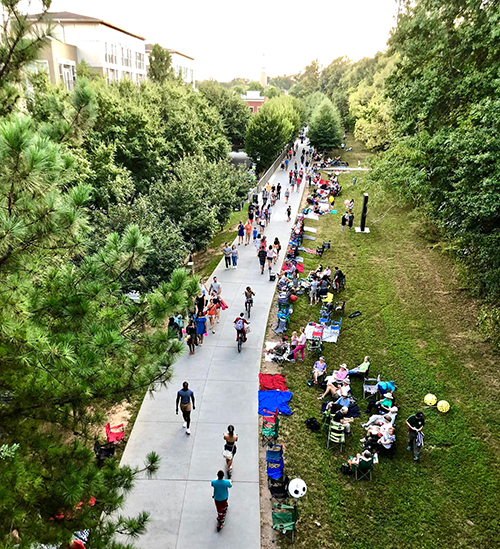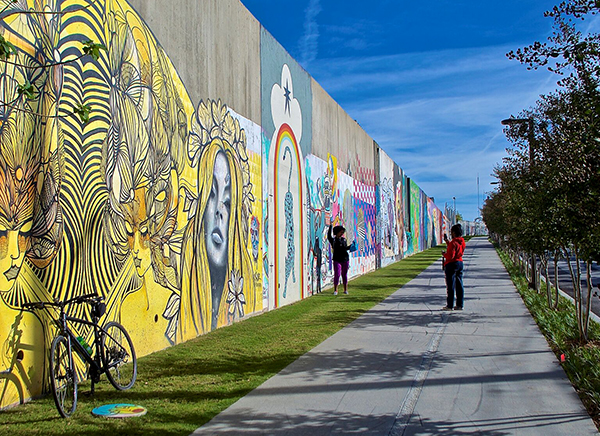 The innovative Atlanta BeltLine - a 22-mile loop of parks, multi-use trails and proposed alternative transportation linking neighborhoods. (Photo by John Becker - Atlanta BeltLine Partnership)
The innovative Atlanta BeltLine - a 22-mile loop of parks, multi-use trails and proposed alternative transportation linking neighborhoods. (Photo by John Becker - Atlanta BeltLine Partnership)
One of the truly remarkable stories about how parks are created is the innovative 22-mile BeltLine project in Atlanta that was inspired by a graduate student's thesis.
The idea of using an abandoned rail corridor built in 1902 encircling the city first sprang up when Georgia Tech student Ryan Gravel first thought of the idea after he reportedly became frustrated with sources of alternative transportation in the area.
He formed a group called Friends of the BeltLine. Working with some colleagues, he created his proposal and mailed it off to several influential people in the city.
The idea took hold.
The project focused on becoming a pedestrian-friendly rail transit with lots of amenities strewn throughout the line.
Fast forward to today and here are some of the details of the project:
- Planned 22-mile loop around Atlanta
- 1,300 acres of parks - These green spaces have been referred to as "The BeltLine Emerald Necklace."
- 33 miles of multi-use trails
- 1,100 acres of brownfields remediated
- Largest public art display in the city
- 30,000 permanent jobs
- 5,600 units of affordable housing
- $10 to 20 billion in economic development
Talking about alternative transportation. Now there are clear paths where people can bike, roller skate and walk from neighborhood to neighborhood - about 45 of them.
Public transportation in the form of streetcars or light rail are also included for future development.
The plan is to also add more parks, trails before the anticipated completion in 2030.
 Art along the BeltLine loop in Atlanta. (Photo by John Becker - Atlanta BeltLine Partnership)
Art along the BeltLine loop in Atlanta. (Photo by John Becker - Atlanta BeltLine Partnership)
BeltLine is a destination unto itself
One of the great ideas behind the Beltline is to not only create a loop for alternative transportation but with its parks, trails and artwork, to make the BeltLine a destination in itself.
Four trail segments are open, as are several parks and the new housing.
Events such as Run, Walk Go! and Art on the Atlanta BeltLine already attract huge followings.
The project has been a catalyst for the refurbishing of old industrial buildings for residential and retail use such as the Amsterdam Walk, Ponce City Market, Ford Factory Lofts, Krog Street Market, The Telephone Factory Lofts, DuPre Exelsior Mill, the Pencil Factory and N.Highland Steel in Inman Park Village.
The project is a collaboration of private and public sector partners and funding comes from federal, state, local and privates sources.
Underline and High Line parks examples of new uses for old spaces
It's amazing what you can do with an old abandoned right of way.
The Beltline is very similar to the High Line park in NYC which attracts about 5 million visitors per year. That project uses only 1.4 miles of an abandoned elevated rail line but it has become a worldwide showcase for clever uses of property in urban areas. The city transformed that old rail line into an interesting urban oasis with beautiful landscaping, public works of art, unique park benches and ongoing events.
Another example is the proposed Underline project in Miami. That project was also initiated by one individual, Meg Daly, who noticed areas of shade created by the elevated Metrorail line overhead. She envisioned an opportunity to create a series of linear parks in those open spaces.
The project has been adopted by the Miami-Dade County Transportation & Public Works Department and the Parks, Recreation and Open Spaces departments. Students and faculty at the University School of Architecture also pitched in.
Plans were drawn up to create 10 miles of urban trails and ground was broken this month!
The Underline's unique series of parks will include biking and running trails, park benches and places to relax, plus exciting outdoor works of art. This creative use of space is sure to also be a "destination" that will attract residents and tourists alike.
That project has also stimulated millions of dollars in new residential development along the pathways.
Experts say in the next 25 years more people will be moving to urban areas. Ironically, that will make it more difficult to find land for public parks.
This innovative use of abandoned rail lines, shade-filled spaces under train tracks or even rooftops of buildings to build parks is a great way to provide all those inhabitants with the precious green and open spaces they need for a better quality of life.
For the Atlanta BeltLine, it all began with just one student's idea for a thesis project.


